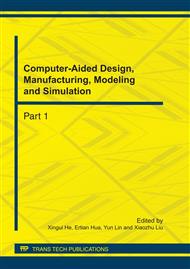[1]
D. D. Lee and H. S. Seung. Learning the parts of objects by non-negative matrix factorization. Nature, 401: 788–791, (1999).
DOI: 10.1038/44565
Google Scholar
[2]
Bernhard Schlkopf and Alex Smola. Learning with Kernels. MIT Press, Cambridge, MA, (2002).
Google Scholar
[3]
Simon Perkins, Kevin Lacker, and James Theiler. Grafting: fast, incremental feature selection by gradient descent in function space. Journal of Machine Learning Research, 3: 1333 – 1356, (2003).
Google Scholar
[4]
Honglak Lee, Alexis Battle, Rajat Raina, and Andrew Y. Ng. Efficient sparse coding algorithms. In Proceedings of the Neural Information Processing Systems (NIPS) 19, (2007).
Google Scholar
[5]
M. R. Osborne, Brett Presnell, and B. A. Turlach. A new approach to variable selection in least squares problems. IMA Journal of Numerical Analysis, 20(3): 389–403, (2000).
DOI: 10.1093/imanum/20.3.389
Google Scholar
[6]
Bradley Efron, Trevor Hastie, Iain Johnstone, and Robert Tibshirani. Least angle regression. Annals of Statistics, 32: 407–499, (2004).
DOI: 10.1214/009053604000000067
Google Scholar
[7]
D. M. Malioutov, M. Cetin, and A. S. Willsky. Homotopy continuation for sparse signal representation. In Proc. ICASSP, (2005).
DOI: 10.1109/icassp.2005.1416408
Google Scholar
[8]
S. S. Chen, D. L. Donoho, and M. A. Saunders. Atomic decomposition by basis pursuit. SIAM J. Scientific Computing, 20(1): 33–61, (1998).
DOI: 10.1137/s1064827596304010
Google Scholar
[9]
M. E. Tipping. Sparse Bayesian learning and the relevance vector machine. Journal of Machine Learning Research, 1: 211–244, (2001).
Google Scholar
[10]
D. J. C. MacKay. Bayesian interpolation. Neural Computation, 4: 415–447, (1992).
Google Scholar
[11]
D. Foresee and M. Hagan. Gauss-Newton approximation to Bayesian regularization. In Proceedings of the 1997 International Joint Conference on Neural Networks, pages 1930–1935, (1997).
DOI: 10.1109/icnn.1997.614194
Google Scholar
[12]
B.A. Olshausen and D.J. Field. Emergence of simple-cell receptive field properties by learning a sparse code for nature images. Nature, 381: 607–609, (1996).
DOI: 10.1038/381607a0
Google Scholar
[13]
Robert Tibshirani. Regression shrinkage and selection via the Lasso. Journal of the Royal Statistical Socity, Series B, (Methodological), 58(1): 267–288, (1996).
DOI: 10.1111/j.2517-6161.1996.tb02080.x
Google Scholar
[14]
E. J. Cand`es, M. Wakin, and S. Boyd. Enhancing sparsity by reweighted l1 minimization. Tech nical Report, California Institute of Technology, (2007).
Google Scholar
[15]
S. J. Wright. Primal-Dual Interior Point Methods. Philadelphia, PA: SIAM, (1997).
Google Scholar
[16]
Dimitri P. Bertsekas. Nonlinear programming. Athena Scientific, (2003).
Google Scholar


